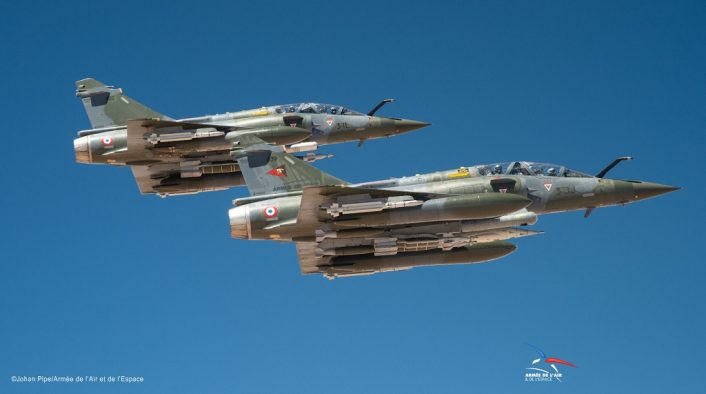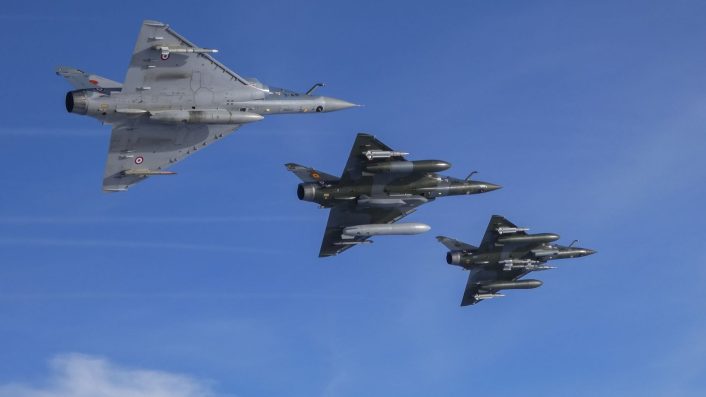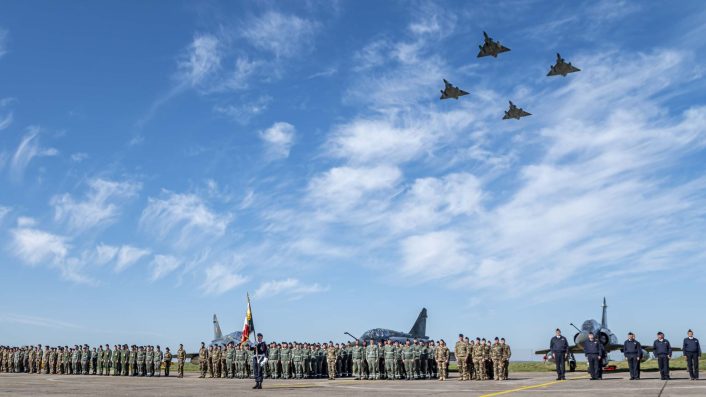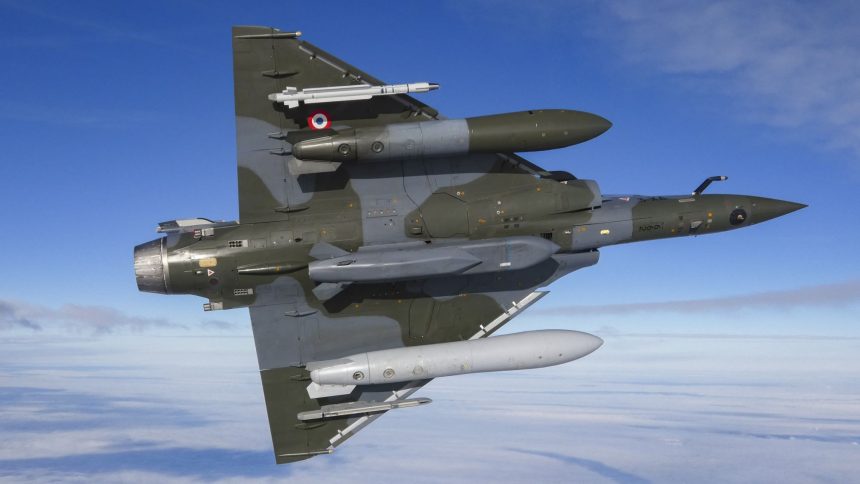The Mirage 2000D underwent a mid-life update to better adapt to the demands of contemporary conflicts and continue to fly until at least 2035.
The Armée de l’Air et de l’Espace (French Air and Space Force) has declared operational the Mirage 2000D RMV (Rénovation Mi-Vie, Mid-Life Update) aircraft, marking the near conclusion of the project to upgrade the specialized ground attack variant of the Mirage 2000. A ceremony to mark the operational commissioning was held at Nancy-Ochey Air Base, which hosts the 3rd Fighter Wing, on Apr. 9, 2025, the French Ministry of the Armed Forces announced, with four of the jets displaying in flight some of the upgrades and new weapons capabilities.
“Nine years to go from concept to reality, from paper to aircraft, from idea to operational commitment. A short decade of work, research, testing, adjustments, and training,” said Major General Vincent Chusseau, Deputy Chief of Plans and Programs for the FASF General Staff. “Behind this success are the engineers, technicians, mechanics, and Airmen who, with determination and rigor, have enabled this aircraft to reach a new milestone.”
The service is expected to receive a total of 50 deeply modernized airframes by late 2025. Expected to serve until 2035, the jet would then be fully replaced by the Rafale F5, itself accompanied by a new UCAV based on the nEUROn.
The new capabilities include: a CC422 30 mm gun pod, installed under the left engine intake; MICA IR AAM (Air-to-Air Missile), replacing the Magic II AAMs; GBU-48 and GBU-50 Enhanced Paveway II dual-mode GPS and laser-guided bombs; a larger and advanced cockpit display, improving interface with the pilot; a new mission computer, powered by mission software like PANDA, LION, SINGE and LIANE, according to Opex360; a TALIOS (Targeting Long-range Identification Optronic System) targeting pod; and the ASTAC (Analyseur de signaux tactiques) electronic warfare system.

The addition of the 30 mm gun pod is notable as the Mirage 2000D is not equipped with internal guns, being derived from the now retired Mirage 2000N which was not fitted with cannons. The CC422 gun pod contains a DEFA 550 F3 30mm cannon, with a reportedly 250 rounds magazine, and is derived from the CC420 pod carried by the Mirage F1Bs.
TALIOS adds commonality with the Rafale fleet and replaces the ATLIS II, PDL CTS, and Damocles pods which has been used until now by the Mirage 2000D. The Mirage 2000D was the only aircraft in the FASF to use the aging Magic II for self defense, and the replacement now standardizes the use of the weapon among both Mirage and Rafale units.
The GBU-48 and GBU-50 add to the already integrated GBU-49, with the upgraded Mirage 2000D now able to employ all 500 lb, 1,000 lb and 2,000 lb variants of the Enhanced Paveway II series. These will be used with the already operational laser-guided bombs from the Paveway II and III series, as well as the SCALP cruise missile.
Nouveaux armements :
– Canon de 30 mm
– Missiles MICA IR
– Bombes guidées laser
Des configurations adaptées aux engagements d’aujourd’hui et de demain. pic.twitter.com/hTT46a9ybE
— Armée de l’Air et de l’Espace (@Armee_de_lair) April 9, 2025
Some of the previously released photos appeared to show pilots equipped with the Scorpion Helmet Mounted Display, the same HMD system that was chosen also for the Rafale. The introduction of this capability was not mentioned among the ones officially confirmed by the FASF.
Images released after the commissioning ceremony showed the upgraded jets flying in multiple configurations. One of these, with overlying graphics highlighting the new capabilities, shows two Mirage 2000Ds carrying MICA IRs on the outermost hardpoints, two external fuel tanks and the TALIOS targeting pod under the right chin station.
The aircraft in the foreground also carried a 2,000 lb GBU-50 on the centerline station and a 1,000 lb GBU-48 on the left chin station, while the aircraft in the background carried two 500 lb GBU-49s on the centerline, the CC422 gun pod on the left chin station and two unguided 500 lb bombs on the rear fuselage stations. This photo was possibly taken during the test campaign in Djibouti in 2021.
Another Mirage 2000D RMV, shown as part of a four ship formation, was carrying a SCALP-EG ALCM (Air-Launched Cruise Missile) on the centerline, and a MICA IR AAM on the outermost station of the right wing. This was accompanied by another airframe carrying two GBU-49s on the centerline, the 30 mm gun and the TALIOS pod.
More lethal Mirages
In its press release, the FASF called the Mirage 2000D a “symbol of precision and reliability,” which the comprehensive modernization program has enabled to adapt to contemporary conflicts. “New optimized weapons systems, improved connectivity and intelligence gathering, and a modernized cockpit all combine to make this aircraft a platform resolutely geared toward a rapidly changing environment,” the statement said.
Commissioned in the 1990s, the Mirage 2000D variant was designed for all weather, day and night ground attack missions, flying at very low altitudes and very high speeds. The “increasingly competitive third dimension” in the “air-to-ground and intelligence domains,” necessitated the RMV program.

The project was launched in 2016 after a contract was awarded to Dassault Aviation. This was two years after it was approved by the Military Programing Law (LPM) of 2014, that aimed at enhancing the aircraft’s operational lifespan. In total, 50 aircraft are planned to be upgraded, with deliveries to be completed later this year.
The 30 mm cannon now introduced new “close fire support capabilities,” while the modern air-to-air MICA IR missiles (replacing the Magic 2) allow “short-range self-defense.” Additionally, the fighter has also received “a renovated architecture of the weapons system allowing the integration of precision weapons, such as the GBU-48 and GBU-50 laser-guided bombs.”
The statement also noted the contribution of the Operational Information Systems and Cyberdefense Squadron (ESIOC) at the 118th Air Base in Mont-de-Marsan, who have been in “direct contact with the crews” and “developing the onboard software of the Mirage 2000 D RMV since 2017.” The modernized navigation and attack systems give the crews “a detailed vision of the situation thanks to continuous updates and sharing of tactical data.”
The statement further adds that “the software installed in the connected dashboard is thus adjusted in a short loop, within a new generation cockpit equipped with digital screens.”
During the ceremony on Apr. 9 at the Nancy-Ochey Air Base, the FASF’s deputy chief of plans and programs Maj. Gen. Vincent Chusseau credited the “determination and rigor” of the engineers, technicians, mechanics, and Airmen. The Airmen assigned to the 3rd Fighter Wing were also present, and they will be at the forefront of maintaining and operating the aircraft in “their daily work in the service of a cutting-edge combat tool.’
Le système d’armes a été repensé :
– Architecture rénovée
– Tableau de bord plus intuitif et numérisé
– Vision tactique ergonomique et en temps réel
Augmenter la réactivité, l’agilité et la précision. pic.twitter.com/s3AUwQNJGv
— Armée de l’Air et de l’Espace (@Armee_de_lair) April 9, 2025
“This new operational tool is finding its place within the 3rd Fighter Wing. It will be operated by highly qualified crews, supported by seasoned mechanics and specialists,” Chusseau added. “This operational commissioning is therefore the culmination of a collective effort. Today, we salute the work of the industrial teams, engineers, and military personnel of the Air and Space Force who made this modernization possible.”
The FASF said the Mirage 2000D’s upgrade embodies the service’s “commitment to maintaining an agile, modern, and resolutely operational combat posture.”
Interestingly, the number of Mirage 2000Ds to be modified to the RMV standard was changed several times, with the initial target of 71 airframes reduced to 55, while social media posts in the middle of March claimed 47 were delivered to the service in 2024. The Ministry of the Armed Forces then said on Mar. 26 the final number was 50.
Testing and development effort
The RMV program also saw a series of extensive tests of the upgraded Mirage 2000Ds, both within France and foreign deployments. Opex360 reported that 2018 and 2019 saw several test campaigns in Cazaux, to validate “the operation, capabilities and precision,” of the 30 mm CC422 cannon.
These were presumably ground tests, as subsequent live airborne tests were held recently. In fact, on Mar. 7, 2025 the FASF shared a video of a Mirage 2000D RMV successfully firing the CC422 on a ground target, calling it a “major milestone” of the Mid-Life Upgrade program.

From Jul. 1 to 20, 2021, the service completed a test campaign in Djibouti when two Mirage 2000D RMVs deployed to the Base Aérienne (Air Base) 188 Djibouti with the Escadron de Chasse et d’Expérimentation (Fighter and Experimental Squadron) 1/30 “Côte d’Argent”. Besides testing the Mirage 2000D RMV in realistic combat conditions in hot weather, the FASF also put the CC422 cannon pod through the paces.
The upgraded Mirages carried out various missions in coordination with the Mirage 2000-5 of the Escadron de Chasse 3/11 “Corsica” and Forward Air Controllers (FAC), testing in demanding climatic conditions the entire “ecosystem” of the aircraft, including support equipment, mission planning and debriefing systems, among others.
🎯💥 Tir canon réussi cette semaine pour le #Mirage2000D. Il valide un jalon majeur de son programme de Rénovation Mi-Vie (RMV). Polyvalence air-sol renforcée et capacités opérationnelles élargies pour le chasseur de l’armée de l’Air et de l’Espace. pic.twitter.com/Zd5ML3I6Zt
— Armée de l’Air et de l’Espace (@Armee_de_lair) March 7, 2025
In the summer of 2022, the 3rd Fighter Wing at Nancy-Ochey received its first Mirage 2000D RMV.









